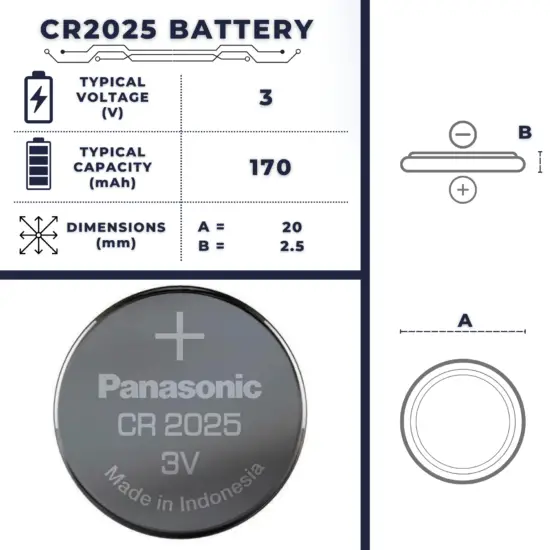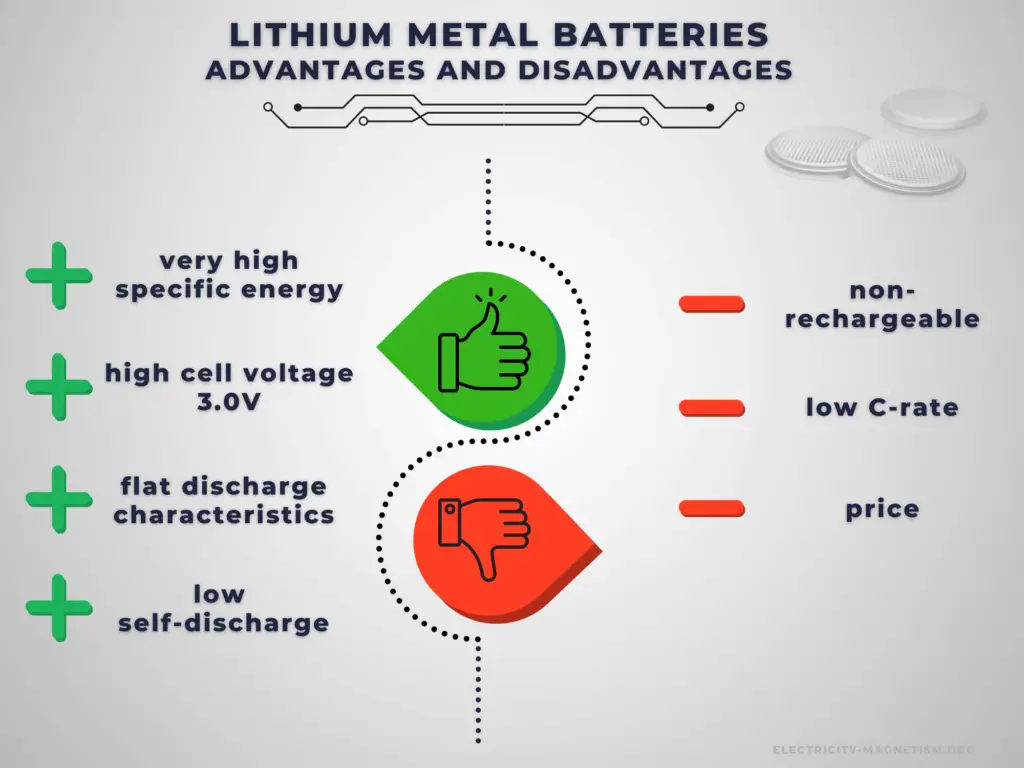30-second summary
CR2025 Battery
A CR2025 battery is a 3V lithium-metal-based button cell that is used in a wide range of applications like computer motherboards, car key fobs, watches, calculators, PDAs, electronic organizers, garage door openers and toys.
Characteristics:
- CR2025 can be used in a wide range of temperatures (-30°C to +60°C)
- High voltage (3V)
- Self-discharge is very low; long shelf life of up to 10 years
- A full line up for use in a wide variety of applications
- No mercury added
- Very high weight-to-power ratio
- High leak protection
In general, lithium metal batteries, such as the CR2025 battery, have a very high energy density, double that of premium alkaline batteries. They also have high cell voltage, flat discharge characteristic, low self-discharge, a very long operating life (15 to 20 years for lithium thionyl chloride), and a wide operating temperature range ( -60 ° C to +85 ° C for lithium-sulfur dioxide), excellent durability, and small cell size.
Overall reaction (Li/MnO2 cells):
Li(s) + MnIVO2(s) ⇌ MnIIIO2(Li+) [E° = +3.19 V]

An electric battery is essentially a source of DC electrical energy. It converts stored chemical energy into electrical energy through an electrochemical process. This then provides a source of electromotive force to enable currents to flow in electric and electronic circuits. A typical battery consists of one or more voltaic cells.
The fundamental principle in an electrochemical cell is spontaneous redox reactions in two electrodes separated by an electrolyte, which is a substance that is ionic conductive and electrically insulated.
A CR2025 battery is a 3V lithium-metal-based button cell that is used in a wide range of applications like computer motherboards, car key fobs, watches, calculators, PDAs, electronic organizers, garage door openers and toys.
Dimensions, Weight and Capacity of CR2025 Battery
CR2025 batteries (20 mm x 2.5 mm) have a nominal diameter of 20 millimeters. The overall height is 2.5 millimeters. Its weight is only 2.6 grams.
Because the CR2025 batteries are chemically very stable, they still have 90% of their original capacity even after 10 years. The stability is the result of the combination of lithium and manganese dioxide. The long-lasting function of these batteries has been verified at all operating temperatures under low-load discharge conditions.
Lithium Metal Batteries
Lithium-based primary cells are batteries that have metallic lithium as an anode. These types of batteries are also referred to as lithium-metal batteries. Note that disposable primary lithium batteries must be distinguished from secondary lithium-ion or lithium-polymer, which are rechargeable batteries. Lithium-ion batteries do not contain metallic lithium.
Primary lithium batteries have the lowest self-discharge rate hence the longest available shelf time, up to 10 years, and in temperatures up to 70. The first letter in the IEC standard system identifies the battery’s chemical composition. C is for lithium metal batteries (as CR2032). The characteristics that make lithium an exceptional electrode material for high energy density batteries include low electrode potential and very high conductivity. It is soft and malleable and can be extruded into thin foils.
They may be classified in several ways, but one convenient method is by the cathode material and voltage. Using an iron disulfide cathode gives a battery with a nominal voltage of 1.5 volts. This cell is used for high-performance AA batteries. Most other lithium batteries are 3.0 volt systems using cathodes comprising either solids (manganese dioxide or carbon monofluoride) or highly toxic liquids (sulfur dioxide or thionyl chloride).
Characteristics of CR2025 Battery
To compare and understand the capability of each battery, some important parameters are characteristic of each battery, also within a type of battery. These parameters are a reference when a battery is needed, and specific qualities are required since batteries are used in all types of devices and for infinite purposes.
Cell Voltage
The voltage of electric batteries is created by the potential difference of the materials that compose the positive and negative electrodes in the electrochemical reaction.
For lithium-manganese dioxide cell, the cell voltage is 3V. The overall reaction is: Li(s) + MnIVO2(s) ⇌ MnIIIO2(Li+) [E° = +3.19 V]
Cut-off Voltage
The cut-off voltage is the minimum allowable voltage. It is this voltage that generally defines the “empty” state of the battery.
The nominal voltage of the CR2025 battery is 3.0 V, and the cutoff voltage is 2.0 V.
Capacity
The coulometric capacity is the total Amp-hours available when the battery is discharged at a certain discharge current from 100% SOC to the cut-off voltage.
The CR2025 battery has a typical capacity of about 170 mAh.
C-rate of Battery
C-rate is used to express how fast a battery is discharged or charged relative to its maximum capacity. It has units h−1. A 1C rate means that the discharge current will discharge the entire battery in 1 hour.
Self-discharge
Batteries gradually self-discharge even if not connected and delivering current. This is due to non-current-producing “side” chemical reactions that occur within the cell even when no load is applied.
The annual self-discharge rate of CR2025 battery at room temperature and normal humidity is less than 1% of the nominal capacity.
Chemistry of Lithium Metal Batteries
In simple terms, each battery is designed to keep the cathode and anode separated to prevent a reaction. The stored electrons will only flow when the circuit is closed. This happens when the battery is placed in a device and the device is turned on.
When the circuit is closed, the stronger attraction for the electrons by the cathode (e.g. manganese dioxide in primary lithium batteries) will pull the electrons from the anode (e.g. lithium metal) through the wire in the circuit to the cathode electrode. This battery chemical reaction, this flow of electrons through the wire, is electricity.
If we go into detail, batteries convert chemical energy directly to electrical energy. For example, chemical energy can be stored in Zn or Li, which are high-energy metals because they are not stabilized by d-electron bonding, unlike transition metals.
Even though a wide range of types of batteries exists with different combinations of materials, all of them use the same principle of the oxidation-reduction reaction. In an electrochemical cell, spontaneous redox reactions take place in two electrodes separated by an electrolyte, which is a substance that is ionic conductive and electrically insulated. The redox reaction is a chemical reaction that produces a change in the oxidation states of the atoms involved. Electrons are transferred from one element to another. As a result, the donor element, which is the anode, is oxidized (loses electrons), and the receiver element, the cathode, is reduced (gains electrons).
In a primary lithium battery, the negative electrode is metallic lithium, and the positive electrode is high-density manganese dioxide (MnO2). The electrolyte in Li/MnO2 cells is an organic solvent mixture into which an alkali metal salt is dissolved. Li+ ions go into the solution and diffuse through the electrolyte and separator to the cathode. Electrons travel through the external circuit and arrive at the cathode where MnO2, Li+ ions, and electrons combine. The MnO2 is reduced from the tetravalent to the trivalent state. The solid discharge reaction product remains in the cathode. No gases are evolved during discharge to cause a pressurized condition
The half-reactions are:
MnIVO2(s) + Li+ + e− → MnIIIO2(Li+)
Li(s) → Li+ + e−
Overall reaction:
Li(s) + MnIVO2(s) ⇌ MnIIIO2(Li+) [E° = +3.19 V]
Applying this battery chemistry to the real world, the electrons generated during the reaction are used to power devices when the circuit is closed.
Advantages and Disadvantages of Lithium Metal Batteries

Advantages:
Primary batteries have higher energy density than rechargeable secondary cells. High specific energy, long storage times (low self-discharge), and instant readiness give primary batteries a unique advantage over other power sources. They are usually the best choice for low-drain applications. They can be carried to remote locations and used instantly, even after long storage; they are also readily available and environmentally friendly when disposed.
Lithium metal batteries have a very high energy density, double that of premium alkaline batteries. They also have high cell voltage, flat discharge characteristic, low self-discharge, a very long operating life (15 to 20 years for lithium thionyl chloride), and a wide operating temperature range ( -60 ° C to +85 ° C for lithium-sulfur dioxide), excellent durability, and small cell size.
Disadvantages:
The main disadvantage of primary batteries is that they are non-rechargeable. Another disadvantage is their low C-rate. Even high current types are considered low in comparison to rechargeable batteries. They are also less environment friendly than rechargeable batteries. The application of primary batteries leads to a large amount of waste batteries to be recycled. For large batteries, primary batteries are usually not cost-effective.
The major disadvantage of lithium metal batteries is their price.
Other Types of Batteries
The following list summarizes notable electric battery types composed of one or more electrochemical cells. Four lists are provided in the table. The first list is a battery classification by size and format. Then, the primary (non-rechargeable) and secondary (rechargeable) cell lists are lists of battery chemistry. The third list is a list of battery applications. The final list is a list of different battery voltages.
Sizes
- AA battery
- AAA battery
- AAAA battery
- C battery
- D battery
- cr1220 battery
- cr1620 battery
- cr1632 battery
- cr1616 battery
- cr2016 battery
- cr2032 battery
- cr2025 battery
- cr2430 battery
- cr2450 battery
- cr123 battery
- cr2 battery
- cr132a battery
- lr1130 battery
- lr41 battery
- lr44 battery
- A23 battery
- a13 battery
- 18650 battery
- 21700 battery






